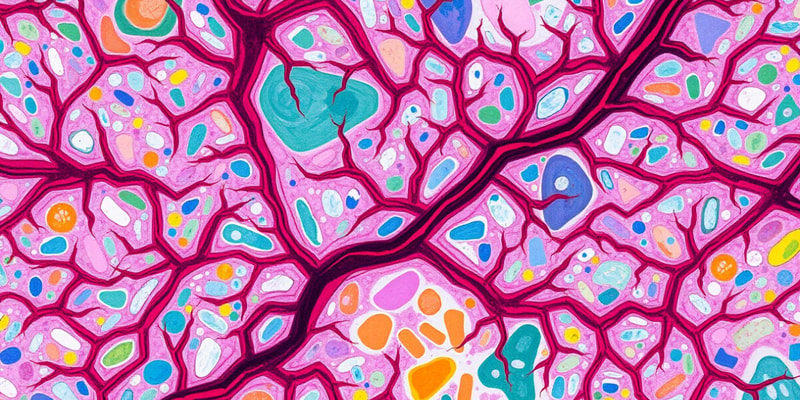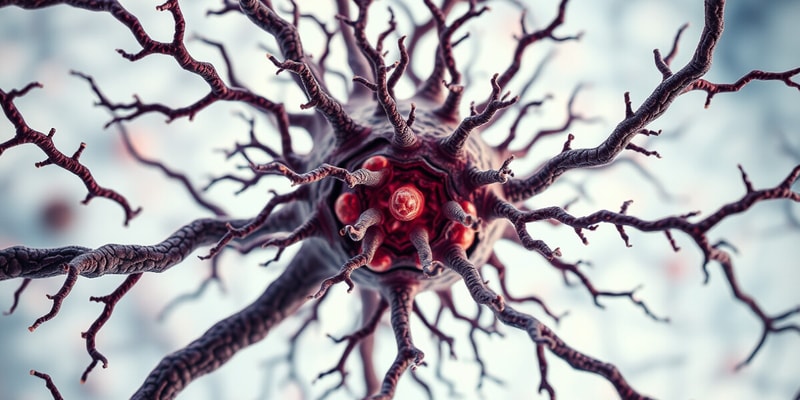Podcast
Questions and Answers
Which part of the neuron contains the nucleus and organelles?
Which part of the neuron contains the nucleus and organelles?
What is the functional unit in both the CNS and PNS?
What is the functional unit in both the CNS and PNS?
How many basic types of neuronal structure are mentioned in the text?
How many basic types of neuronal structure are mentioned in the text?
Which type of neuron has one axon and two or more dendrites?
Which type of neuron has one axon and two or more dendrites?
Signup and view all the answers
Which type of neuron has one dendrite and one axon?
Which type of neuron has one dendrite and one axon?
Signup and view all the answers
Which part of the neuron is specialized to receive stimuli from other neurons?
Which part of the neuron is specialized to receive stimuli from other neurons?
Signup and view all the answers
What is the primary function of astrocytes in the nervous system?
What is the primary function of astrocytes in the nervous system?
Signup and view all the answers
Which cells are responsible for producing myelin in the central nervous system?
Which cells are responsible for producing myelin in the central nervous system?
Signup and view all the answers
What is the primary role of ependymal cells in the nervous system?
What is the primary role of ependymal cells in the nervous system?
Signup and view all the answers
What is the primary function of microglia in the brain?
What is the primary function of microglia in the brain?
Signup and view all the answers
What is the primary purpose of the blood-brain barrier (BBB) in the central nervous system (CNS)?
What is the primary purpose of the blood-brain barrier (BBB) in the central nervous system (CNS)?
Signup and view all the answers
What is the main function of the meninges in the central nervous system?
What is the main function of the meninges in the central nervous system?
Signup and view all the answers
What is the primary role of pseudounipolar neurons in the nervous system?
What is the primary role of pseudounipolar neurons in the nervous system?
Signup and view all the answers
What type of cells form a protective layer surrounding gray matter in the nervous system?
What type of cells form a protective layer surrounding gray matter in the nervous system?
Signup and view all the answers
Which type of neuron comprises the sensory neurons of the retina, the olfactory epithelium, and the inner ear?
Which type of neuron comprises the sensory neurons of the retina, the olfactory epithelium, and the inner ear?
Signup and view all the answers
What is the primary function of ependymal cells in the nervous system?
What is the primary function of ependymal cells in the nervous system?
Signup and view all the answers
What is the main function of the meninges in the central nervous system?
What is the main function of the meninges in the central nervous system?
Signup and view all the answers
What is the primary purpose of the blood-brain barrier (BBB) in the central nervous system (CNS)?
What is the primary purpose of the blood-brain barrier (BBB) in the central nervous system (CNS)?
Signup and view all the answers
What is the primary role of microglia in the brain?
What is the primary role of microglia in the brain?
Signup and view all the answers
What is the primary function of astrocytes in the nervous system?
What is the primary function of astrocytes in the nervous system?
Signup and view all the answers
What type of cells form a protective layer surrounding gray matter in the nervous system?
What type of cells form a protective layer surrounding gray matter in the nervous system?
Signup and view all the answers
Which part of the neuron is specialized to receive stimuli from other neurons?
Which part of the neuron is specialized to receive stimuli from other neurons?
Signup and view all the answers
What is the functional unit in both the CNS and PNS?
What is the functional unit in both the CNS and PNS?
Signup and view all the answers
What is the primary role of pseudounipolar neurons in the nervous system?
What is the primary role of pseudounipolar neurons in the nervous system?
Signup and view all the answers
What type of cells are responsible for producing myelin in the central nervous system?
What type of cells are responsible for producing myelin in the central nervous system?
Signup and view all the answers
What is the primary function of oligodendrocytes in the central nervous system?
What is the primary function of oligodendrocytes in the central nervous system?
Signup and view all the answers
What is the primary role of the meninges in the central nervous system?
What is the primary role of the meninges in the central nervous system?
Signup and view all the answers
What is the main function of astrocytes in the nervous system?
What is the main function of astrocytes in the nervous system?
Signup and view all the answers
What is the primary purpose of the blood-brain barrier (BBB) in the central nervous system (CNS)?
What is the primary purpose of the blood-brain barrier (BBB) in the central nervous system (CNS)?
Signup and view all the answers
What is the primary role of microglia in the brain?
What is the primary role of microglia in the brain?
Signup and view all the answers
Which cells are responsible for producing myelin in the central nervous system?
Which cells are responsible for producing myelin in the central nervous system?
Signup and view all the answers
What is the primary function of ependymal cells in the nervous system?
What is the primary function of ependymal cells in the nervous system?
Signup and view all the answers
What type of cells form a protective layer surrounding gray matter in the nervous system?
What type of cells form a protective layer surrounding gray matter in the nervous system?
Signup and view all the answers
What is the primary role of pseudounipolar neurons in the nervous system?
What is the primary role of pseudounipolar neurons in the nervous system?
Signup and view all the answers
What is the primary function of the cerebral cortex in the central nervous system?
What is the primary function of the cerebral cortex in the central nervous system?
Signup and view all the answers
What is the main function of capillaries in the central nervous system?
What is the main function of capillaries in the central nervous system?
Signup and view all the answers
Study Notes
-
Pseudounipolar neurons are primarily sensory neurons near the Central Nervous System (CNS).
-
Brain and spinal cord are covered by three protective membranes called meninges.
-
The brain and spinal cord are made up of gray matter and white matter.
-
Gray matter (pia mater) is a thin layer with abundant nerve fibers, glia, and blood vessels.
-
White matter (dura mater and arachnoid layer) is a protective layer made of fibrous tissue and collagen.
-
Cerebrospinal fluid (CSF) fills the brain ventricles and spinal cord, providing mechanical and immunological protection.
-
Lumbar puncture is a medical procedure to collect CSF for diagnostic testing.
-
Astrocytes are the largest neuroglial cells, helping neurons by maintaining tight junctions and metabolic support.
-
Oligodendrocytes produce myelin, and one cell myelinates many axons.
-
Microglia are phagocytic cells, protecting the brain from infection and injury.
-
Ependymal cells line the ventricles and produce CSF.
-
Blood-brain barrier (BBB) is a functional barrier that tightly controls the passage of substances into the CNS.
-
Choroid plexus in the ventricles produces CSF and removes water from blood.
-
The cerebrum consists of white matter and gray matter, with the cortex being highly convoluted.
-
The cerebral cortex contains various neuronal and glial cells, including Betz's pyramidal cells, capillaries, oligodendrocytes, astrocytes, and microglia.
-
The cerebellum's white matter forms a branched tree-like structure.
-
The Purkinje layer is an intermediate layer in the cerebellum with large Purkinje cells and tree-like dendritic arborizations.
-
Pseudounipolar neurons are primarily sensory neurons near the Central Nervous System (CNS).
-
Brain and spinal cord are covered by three protective membranes called meninges.
-
The brain and spinal cord are made up of gray matter and white matter.
-
Gray matter (pia mater) is a thin layer with abundant nerve fibers, glia, and blood vessels.
-
White matter (dura mater and arachnoid layer) is a protective layer made of fibrous tissue and collagen.
-
Cerebrospinal fluid (CSF) fills the brain ventricles and spinal cord, providing mechanical and immunological protection.
-
Lumbar puncture is a medical procedure to collect CSF for diagnostic testing.
-
Astrocytes are the largest neuroglial cells, helping neurons by maintaining tight junctions and metabolic support.
-
Oligodendrocytes produce myelin, and one cell myelinates many axons.
-
Microglia are phagocytic cells, protecting the brain from infection and injury.
-
Ependymal cells line the ventricles and produce CSF.
-
Blood-brain barrier (BBB) is a functional barrier that tightly controls the passage of substances into the CNS.
-
Choroid plexus in the ventricles produces CSF and removes water from blood.
-
The cerebrum consists of white matter and gray matter, with the cortex being highly convoluted.
-
The cerebral cortex contains various neuronal and glial cells, including Betz's pyramidal cells, capillaries, oligodendrocytes, astrocytes, and microglia.
-
The cerebellum's white matter forms a branched tree-like structure.
-
The Purkinje layer is an intermediate layer in the cerebellum with large Purkinje cells and tree-like dendritic arborizations.
Studying That Suits You
Use AI to generate personalized quizzes and flashcards to suit your learning preferences.
Related Documents
Description
Test your knowledge of the histology of the central nervous system with this quiz. Explore the structure of nerve cells, the anatomy of the central and peripheral nervous systems, and the distribution of myelin.




